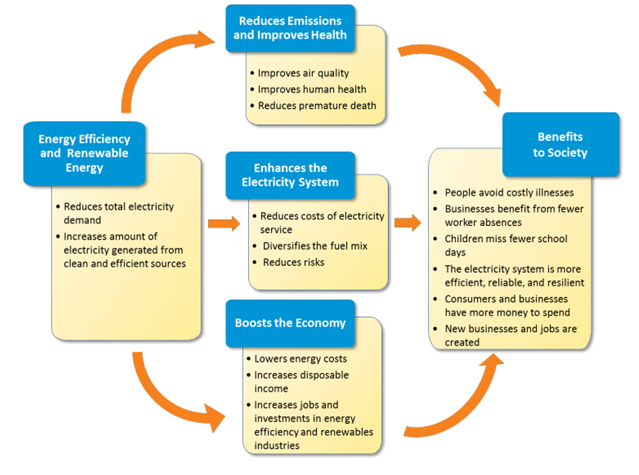Sustainable energy 101: get informed - problem & opportunities
About this step
Gaining an understanding of the issues surrounding energy and environmental sustainability is the first step in reducing your company’s carbon footprint. Here, we’ll walk you through all the essentials you need to know before embarking on your own strategic energy management plan
What is the problem?
Fossil fuels are burned to supply energy, and as energy demand has grown exponentially over the past few centuries, so have carbon emissions and their concentration in our atmosphere. Globally, energy-related carbon emissions account for two-thirds of all greenhouse gas emissions.
In order to halt the worst effects of climate change, such as more extreme weather events and the disappearance of coastal communities, we must act now. According to a landmark report by the IPCC, a window of only 11 years remains for us to take the sweeping measures that would be necessary to limit global warming to 1.5°C — a threshold beyond which devastating and widespread impacts can be expected. 2017 was a huge setback to progress with the United States government backing out of the Paris Climate Agreement and energy-related carbon emissions rising 1.4 percent after a three-year plateau. By reducing its energy consumption and switching to low-emission fuel sources, your company will be doing its part to reduce our shared carbon footprint and help prevent catastrophic climate change.
By managing your energy use, your company will also be helping to cut pollution from fossil fuels and associated health impacts. Pollution from coal-fired power plants, for example, is linked to various ailments and even premature death; in 2010, pollution from U.S. coal plants caused some 13,200 deaths, 9,700 hospitalizations and 20,000 heart attacks. Those health impacts translate to immense dollar impacts. One estimate from EPA puts the economic value of health impacts from fossil fuel electricity in the United States at 2.5-6.0 percent of the national GDP annually.

Why should your company care?
A company managing their energy-related emissions may enjoy numerous benefits:
Cost savings
Companies managing their energy use can expect substantial cost savings. The International Energy Agency estimates that two-thirds of the global economic potential of energy efficiency remains untapped. By tapping into your company’s full energy efficiency potential, you’ll cut back on how much energy your company uses — and how much it spends on its utility bill.
Making renewables a larger share of your company’s energy mix can also cut costs. The International Renewable Energy Agency reported in 2017 that the cost of renewable power generation would soon cost as much as that of fossil fuels — if not less. And while installing your own renewable energy sources, such as solar panels, may present a large upfront cost, your company will see a return on your investment and multiple economic benefits in the long term, such as federal tax credits.
Risk mitigation
The effects of climate change are already impacting companies directly. Higher temperatures, extreme weather events, sea level rise and water stress can increase operational costs, weaken production capacity, make resources more scarce, and more — all of which increase the cost of doing business. Failure to act aggressively will mean those adverse impacts to business and the economy are guaranteed to intensify. The U.S. government’s Fourth National Climate Assessment predicts hundreds of billions of dollars in annual losses in some economic sectors if we do not act to reduce emissions.
Not convinced? Here are 900+ examples of how climate change affects business from Forbes.
In addition, a company diversifying its energy portfolio in order to reduce its carbon footprint will limit its exposure to energy-related risks, such as the electric grid reliability and price volatility of fossil fuels. Deploying energy efficiency and on-site renewable energy can ease strain on the grid, making it less prone to outages, and even enhance power quality. Managing your energy use sustainably is a smart business decision.
Enhanced brand reputation
Today’s consumers, shareholders and investors are more socially and environmentally conscious than ever — and want to support businesses that care about more than just the bottom line. Seventy percent of American consumers said they believe companies have an obligation to take actions to improve issues that may not be relevant to everyday business operations, and 87 percent would buy products from brands that advocated for an issue they cared about, according to the 2017 Cone Communications CSR Study.
The CEO of the world’s largest asset manager, BlackRock, issued a letter to business leaders urging them to make a positive contribution to society. Companies that demonstrate their commitment to a low carbon future by managing their energy usage and reporting emissions will project a positive image — one which will entice potential consumers and investors.
Increased competitiveness
Managing your energy-related emissions will be necessary to maintaining your competitive edge. In addition to the cost and risk reduction benefits that contribute to economic competitiveness, companies will also have to respond to constituents’ calls for more responsible environmental practices to maintain customers and revenue. Just look at the Fortune 500, where 48 percent of companies have set at least one climate or clean energy target, up five percent from 2014 to 2017.
The trend is even stronger among the leaders of the pack: In the Fortune 100, the proportion of companies that have set one or more clean energy targets is 63 percent. Those figures will only continue to grow. Companies that do not improve their energy performance will soon be in the minority — and fall behind.
Greater organizational alignment
Companies suffering from poor organizational alignment — where sustainability goals are not aligned with business processes, procedures and goals — may have difficulty accomplishing their business goals, let alone their environmental goals. An energy management program can help with both. Developing a comprehensive energy management program requires coordination and communication between employees at many different levels of your organization, and can help tear down silos between otherwise disparate teams.
Beyond the walls of your company
Your company’s sustainable energy practices will contribute to wider economic and societal benefits.
A thriving economy and society
Energy efficiency and renewable energy deployment drives improvements in public health, the electricity system and the economy, which, in turn, benefit society (see Figure, right: The Multiple Benefits of Energy Efficiency and Renewable Energy. EPA. 2018).
Green jobs will be added to the economy; businesses and consumers will be banking energy savings; pollution-related illness and death will become much less frequent; and much more. When the economy and society thrive, your company will be operating in a more robust business environment — and it, too, will thrive.

What are scope 1, 2 and 3 emissions?
If you’re considering reporting your energy-related emissions to a greenhouse gas reporting program, you’ll need to familiarize yourself with an emissions measuring framework consisting of three “scopes”:
Scope 1
Emissions which result from direct activities of your company, such as fuel combustion from facilities and vehicles that your company owns or controls.
Scope 2
Emissions which result from the generation of purchased electricity consumed by your company, such as purchased electricity, steam, heating and cooling.
Scope 3
Emissions from all other indirect sources in your company’s supply chain, such as purchased raw goods, distribution and transportation, employee commuting, use of sold products, and end of life treatment.
For more on scopes 1, 2 and 3 emissions, see our overview of carbon accounting.